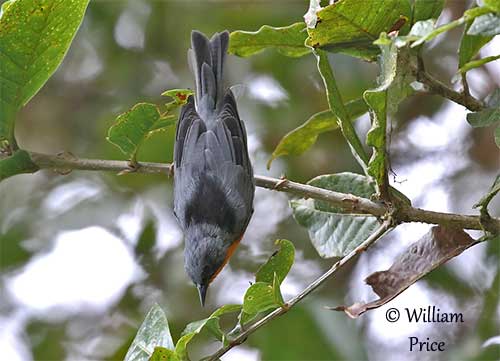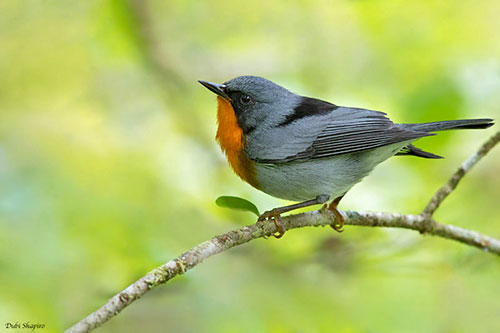
Fr: Paruline embrasée
Ang: Flame-throated Warbler
All: Feuerwaldsänger
Esp: Reinita Flamígera
Esp (Costa Rica): Reinita garganta de fuego
Esp (Panama): Reinita Gorguirroja
Ita: Parula golaflammea
Nd: Vuurkeelzanger
Sd: flamstrupig skogssångare
Photographers:
Dubi Shapiro
Dubi Shapiro Photo Galleries
William Price
PBase-tereksandpiper & Flickr William Price
Text by Nicole Bouglouan
Sources:
HANDBOOK OF THE BIRDS OF THE WORLD Vol 15 by Josep del Hoyo-Andrew Elliot-David Christie - Lynx Edicions – ISBN: 9788496553682
Birds of Costa Rica: A Field Guide De Carrol L. Henderson, Steve Adams – Editeur: University of Texas Press, 2010 – ISBN: 0292719655, 9780292719651 - 387 pages
THE AVIANWEB - Beauty of Birds (Sibylle Faye)
Wikipedia, la enciclopedia libre
Oreothlypis gutturalis
Passeriformes Order – Parulidae Family
INTRODUCTION:
The Slate-throated Warbler is a New World warbler of the family Parulidae. It is found in Costa Rica and Panama.
This species was formerly classified in the genus Vermivora before to be placed in the genus Parula. Actually, the plumage pattern is closest of Parula but the long-pointed, unicoloured bill is rather similar to Vermivora.
But since 2008, the Slate-throated Warbler was placed in the genus Oreothlypis with a second species, the Crescent-chested Warbler (O. superciliosa). This change was accepted in 2019.
The Slate-throated Warbler is resident in the mountains of Costa Rica and W Panama, up to the treeline. It feeds on a variety of invertebrates found in the foliage.
This territorial warbler nests in a cup-shaped structure built in epiphytes, either low on bank or higher in tree.
The Slate-throated Warbler is a restricted-range species. It is described as “fairly common” and it is not globally threatened.
The species was described in 1861 by the German ornithologist Jean Louis Cabanis (1816-1906).

DESCRIPTION OF THE BIRD:
Biometrics:
Length: 12 cm
Weight: 10 gr
The Slate-throated Warbler adult male has slate-grey upperparts with black, triangular patch on the mantle. On the upperwing, the flight-feathers are darker grey. The tail is blackish with outer rectrices edged slate-grey on outer webs.
On the underparts, chin, throat and breast are bright orange. This coloured patch is bordered by a dark band, and contrasts strongly with the paler grey rest of underparts. Flanks are greyer whereas belly and undertail-coverts are white.
On the slate-grey head, lores and lower ear-coverts are blackish.
The pointed bill is blackish. The eyes are dark brown. Legs and feet are pinkish-grey.
The female resembles male but her plumage is slightly duller, with paler grey head and upperparts. There is sometimes a pale brown wash on the latter. The black patch on the mantle is smaller. Throat and breast are more orange-yellow. She has less black on the head.
The juvenile has brownish-grey head and upperparts. On the upperwing, we can see two dark buff wingbars formed by the tips of greater and median upperwing coverts. Throat and breast are olive-buff whereas lower underparts are buffy-white.
The 1st year is slightly duller than adult.
The 1st year female is particularly dull, with brown tinge on head and upperparts, and pale orange/yellow throat and breast.
RANGE:
The Slate-throated Warbler is resident is the mountains from NC Costa Rica (Cordillera Central) S to W Panama (W Chiriquí).
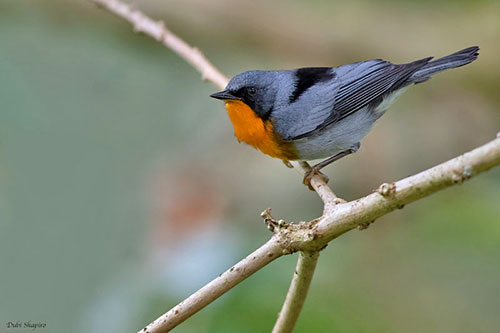
HABITAT:
The Slate-throated Warbler favours the high mountain oak forest where it frequents the canopy, but it also frequents forest edges, clearings and brushy or forested ravines.
The species occurs mainly from 1,850 metres, up to the treeline at 3,000 metres of elevation. During the wet season, it can be seen down to 2,000 metres, and around 1,400 metres outside of breeding season.
CALLS AND SONGS: SOUNDS BY XENO-CANTO
The Slate-throated Warbler’s call is a sharp, high-pitched “chit” or “chip”.
The song is a series of high-pitched notes followed by weak, insect-like buzz rising in pitch “pi pipipipi shwaaaa”.
BEHAVIOUR IN THE WILD:
The Slate-throated Warbler feeds mainly on a variety of invertebrates, but its diet also includes mistletoe berries (Loranthaceae). Arthropod’s diet contains caterpillars, various insects and spiders.
An observation in Costa Rica in 2015 described the bird feeding on nectar from flowers on a tree Blakea grandiflora of family Melastomataceae along a trail.
The warbler was observed feeding at more than five flowers on the same tree by entering the pointed bill into each corolla while perched on a small branch in front of the flower.
The bird was in a mixed-species flock, but it was the only one to feed on nectar.
This information is new concerning the diet of the Slate-throated Warbler which was primarily known as an insect-eater. (Marcelo Coralla-Astía – Costa Rica).
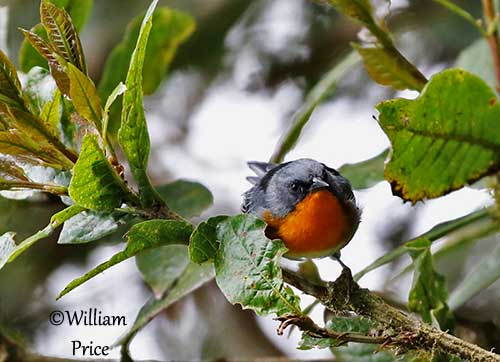
The Slate-throated Warbler forages actively in the canopy, often performing acrobatic movements to reach the food. It searches for food items among foliage, dead leaves and inflorescences, by probing, hanging, gleaning and sallying.
It can be seen alone or in pairs, but outside of breeding season, it often forms flocks of up to 30 individuals.
It may forage in mixed-species flocks.
The breeding behaviour of this species is poorly known, but most tropical warblers usually pair for life and remain in the territory or close to it. The New World warblers are generally monogamous.
The courtship displays are unknown, but the bright-coloured throat and breast are probably fluffed to enhance their colour. On the other hand, the black triangular patch on the mantle could be emphasized by bowing displays, a relatively common behaviour among Parulidae species.
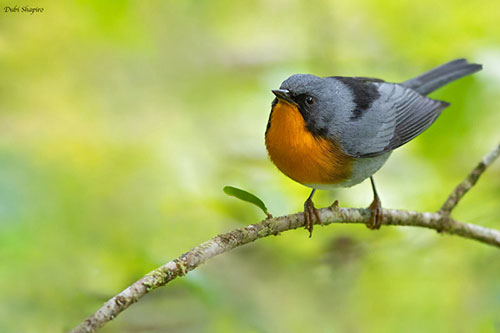
The Slate-throated Warbler is mainly sedentary, although some altitudinal movements to lower elevations, especially on the Caribbean slope, are observed in the latter part of the rainy season.
It moves easily with fast and agile flight.
REPRODUCTION OF THIS SPECIES:
The breeding season takes place from March through May.
The Slate-throated Warbler builds a cup-shaped nest with mosses and green plants. This structure is protected above by vegetation such as grass, epiphytes and mosses. It is sometimes placed on a bank, protected above by the overhanging grass, but it may also be build high in tree up to 21 metres above the ground, under bromeliads or mosses.
The female lays 2 white eggs, sometimes with faint, fine brownish markings. The incubation is apparently performed by the female alone during about 16 days. The chicks are fed by both parents and the young leave the nest 13 days after hatching.
PROTECTION / THREATS / STATUS:
The Slate-throated Warbler is described as “fairly common” within its restricted range where the habitat is not fragmented.
The size of the population is unknown, but it is suspected to be declining due to ongoing habitat destruction.
However, the species is not globally threatened and the Slate-throated Warbler is currently evaluated as Least Concern.
